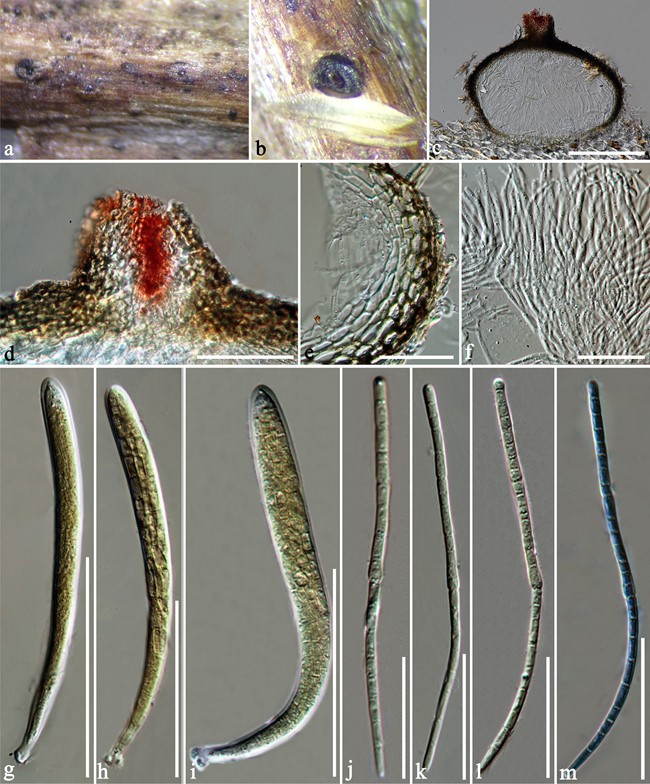Longispora clematidis Phukhams. & K.D. Hyde, sp. nov.
MycoBank number: MB 557199; Index Fungorum number: IF 557199; Facesoffungi number: FoF 07306; Fig. 55.
Etymology: The epithet reflects the host Clematis. Holotype: MFLU 20–0420.
Saprobic on dead stems of Clematis vitalba. Sexual morph: Ascomata 324–340 × 362–368 μm ( x̄ = 332 × 365 μm, n = 5), solitary, scattered, immersed to erumpent through host tissue, only black shiny dots are visible on the host surface, subglobose to compressed, cupulate when dry, brown to dark brown, with brown hyphae projecting from the peridium, ostiolate. Ostioles 79–105 × 75–85 μm ( x̄ = 94 × 80 μm, n = 5), papillate, oblong, brown to light brown, heavily pigmented at outer layer, smooth, filled with periphyses, with a reddish to orange colouration around the pore. Peridium 15–30(–35) μm wide, up to 50 μm at apex, wider at the apex, comprising 6(–8)-layers of brown-walled cells of textura angularis, outer layer heavily pigmented, with inner region comprising hyaline cells of textura angularis. Hamathecium composed of numerous, 2–4 μm wide (n = 50), branched, filamentous, septate, cellular pseudoparaphyses. Asci 97–157 × 9–15 μm ( x̄= 128 × 12 μm, n = 35), 8-spored, bitunicate, cylindrical- clavate, with short bulbose pedicel, apically rounded, with visible ocular chamber. Ascospores 93–124 × 2–5 μm ( x̄= 110 × 4 μm, n = 40), fasciculate, scolecosporous, ends rounded, hyaline when immature, pale brown at maturity, with minute guttule in each cell, (17–)19–23-septate, swollen near the septa between the 11th or 13th or 14th cell, deeply constricted at the swollen cell, slightly contricted at the other septa, not separating into part spores, indentations present. Asexual morph: Undetermined.
Culture characters: Colonies on MEA reaching 20 mm diam. after 4 weeks at 16 °C. Culture slow growing, black, dense, rhizoid, raised with concave edge, rough, irregular at the margins; reverse: black, dense, not pigmented.
Material examined: Italy, Forlì-Cesena Province, Viale Salinatore—Forlì City, on dead aerial branch of Clematis vitalba, 23 February 2015, E. Camporesi, IT2389B (MFLU 20–0420, holotype).
Hosts: Clematis vitalba—(This study).
Distribution: Italy—(This study).
GenBank accession numbers: LSU: MT214580; SSU: MT226693; ITS: MT310625; tef1: MT394639.
Notes: Longispora clematidis is characterized by having sessile, cupulate ascomata, reddish orange ostioles, cellular pseudoparaphyses, cylindric-clavate asci with a bulbose pedicel and filiform ascospores, which are multi-septate and swollen between the 11th–14th cells (Fig. 55). We intro- duce L. clematidis based on morphological and phylogenetic analyses.

Fig. 55 Longispora clematidis (MFLU 20–0420, holotype). a, b Appearance of ascomata on Clematis vitalba. c Vertical section through ascoma. d Ostiolar canal. e Section of peridium. f Pseudo- paraphyses. g–i Asci. j–m Ascospores (m Ascospore in cotton blue). Scale bars: c = 100 µm, d–f, j–m = 20 µm, g–i = 50 µm
